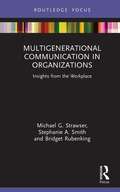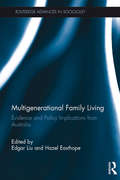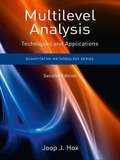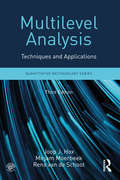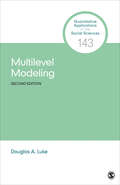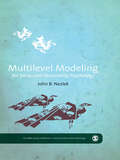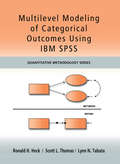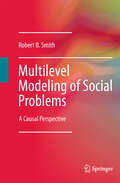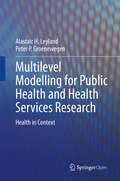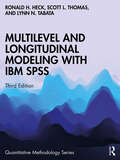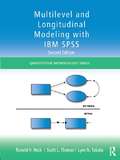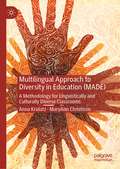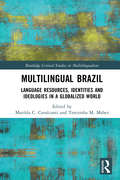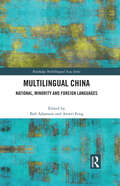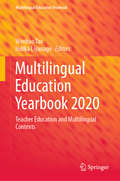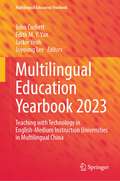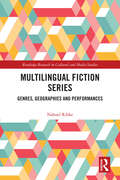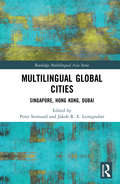- Table View
- List View
Multigenerational Communication in Organizations: Insights from the Workplace (Routledge Focus on Communication Studies)
by Michael G. Strawser Stephanie A. Smith Bridget RubenkingMultigenerational Communication in Organizations explores generational differences in the changing workplace from a communication perspective. Starting from the reality that a workplace can contain up to five different generations, these chapters examine topics like generational perceptions on the job search process; organizational culture; organizational identification; organizational crises; the dark side of workplace communication; remote working; and future challenges. Outlines of best practices and suggestions for application are provided based on the most recent data and corresponding literature. The authors also develop a data-forward understanding of Generation Z in context. This book is ideal for both scholars and practitioners in organizational communication and management, as well as for workplace managers and supervisors.
Multigenerational Family Living: Evidence and Policy Implications from Australia (Routledge Advances in Sociology)
by Edgar Liu Hazel EasthopeMultigenerational living – where more than one generation of related adults cohabit in the same dwelling – is recognized as a common arrangement amongst many Asian, Middle Eastern and Southern European cultures, but this arrangement is becoming increasingly familiar in many Western societies. Much Western research on multigenerational households has highlighted young adults' delayed first home leaving, the result of difficult economic prospects and the prolonged adolescence of generation Y. This book shows that the causes and results of this phenomenon are more complex. The book sheds fresh light on a range of structural and social drivers that have led multigenerational families to cohabit and the ways in which families negotiate the dynamic interactions amongst these drivers in their everyday lives. It critically examines factors such as demographics, the environment, culture and family considerations of identity, health, care and well-being, revealing how such factors reflect (and are reflected by) a retracting welfare state and changing understandings of families in an increasingly mobile world. Based on a series of qualitative and quantitative research projects conducted in Australia, the book provides an interdisciplinary examination of intergenerational cohabitation that explores a variety of concerns and experiences. It will appeal to scholars across the social sciences with interests in housing, demographics and the sociology of the family.
Multilevel Analysis: Techniques and Applications, Second Edition
by Joop J. Hox Rens van de Schoot Mirjam MoerbeekThis practical introduction helps readers apply multilevel techniques to their research. Noted as an accessible introduction, the book also includes advanced extensions, making it useful as both an introduction and as a reference to students, researchers, and methodologists. Basic models and examples are discussed in non-technical terms with an emphasis on understanding the methodological and statistical issues involved in using these models. The estimation and interpretation of multilevel models is demonstrated using realistic examples from various disciplines. For example, readers will find data sets on stress in hospitals, GPA scores, survey responses, street safety, epilepsy, divorce, and sociometric scores, to name a few. The data sets are available on the website in SPSS, HLM, MLwiN, LISREL and/or Mplus files. Readers are introduced to both the multilevel regression model and multilevel structural models. Highlights of the second edition include: Two new chapters--one on multilevel models for ordinal and count data (Ch. 7) and another on multilevel survival analysis (Ch. 8). Thoroughly updated chapters on multilevel structural equation modeling that reflect the enormous technical progress of the last few years. The addition of some simpler examples to help the novice, whilst the more complex examples that combine more than one problem have been retained. A new section on multivariate meta-analysis (Ch. 11). Expanded discussions of covariance structures across time and analyzing longitudinal data where no trend is expected. Expanded chapter on the logistic model for dichotomous data and proportions with new estimation methods. An updated website at http://www.joophox.net/ with data sets for all the text examples and up-to-date screen shots and PowerPoint slides for instructors. Ideal for introductory courses on multilevel modeling and/or ones that introduce this topic in some detail taught in a variety of disciplines including: psychology, education, sociology, the health sciences, and business. The advanced extensions also make this a favorite resource for researchers and methodologists in these disciplines. A basic understanding of ANOVA and multiple regression is assumed. The section on multilevel structural equation models assumes a basic understanding of SEM.
Multilevel Analysis: Techniques and Applications, Third Edition (Quantitative Methodology Series )
by Joop J. Hox Rens van de Schoot Mirjam MoerbeekApplauded for its clarity, this accessible introduction helps readers apply multilevel techniques to their research. The book also includes advanced extensions, making it useful as both an introduction for students and as a reference for researchers. Basic models and examples are discussed in nontechnical terms with an emphasis on understanding the methodological and statistical issues involved in using these models. The estimation and interpretation of multilevel models is demonstrated using realistic examples from various disciplines including psychology, education, public health, and sociology. Readers are introduced to a general framework on multilevel modeling which covers both observed and latent variables in the same model, while most other books focus on observed variables. In addition, Bayesian estimation is introduced and applied using accessible software.
Multilevel Modeling (Quantitative Applications in the Social Sciences #143)
by Douglas A. LukeMultilevel Modeling is a concise, practical guide to building models for multilevel and longitudinal data. Author Douglas A. Luke begins by providing a rationale for multilevel models; outlines the basic approach to estimating and evaluating a two-level model; discusses the major extensions to mixed-effects models; and provides advice for where to go for instruction in more advanced techniques. Rich with examples, the Second Edition expands coverage of longitudinal methods, diagnostic procedures, models of counts (Poisson), power analysis, cross-classified models, and adds a new section added on presenting modeling results. A website for the book includes the data and the statistical code (both R and Stata) used for all of the presented analyses.
Multilevel Modeling (Quantitative Applications in the Social Sciences #143)
by Douglas A. LukeMultilevel Modeling is a concise, practical guide to building models for multilevel and longitudinal data. Author Douglas A. Luke begins by providing a rationale for multilevel models; outlines the basic approach to estimating and evaluating a two-level model; discusses the major extensions to mixed-effects models; and provides advice for where to go for instruction in more advanced techniques. Rich with examples, the Second Edition expands coverage of longitudinal methods, diagnostic procedures, models of counts (Poisson), power analysis, cross-classified models, and adds a new section added on presenting modeling results. A website for the book includes the data and the statistical code (both R and Stata) used for all of the presented analyses.
Multilevel Modeling for Social and Personality Psychology (The SAGE Library of Methods in Social and Personality Psychology)
by John B. NezlekThe volume begins with a rationale for multilevel modeling (MLM). Different aspects of MLM such as centering and modeling error terms are discussed, and examining hypotheses within the multilevel framework is considered in detail. Step by step instructions for conducting multilevel analyses using the program HLM are presented, and these instructions are linked to data sets and program files on a website. The SAGE Library in Social and Personality Psychology Methods provides students and researchers with an understanding of the methods and techniques essential to conducting cutting-edge research. Each volume within the Library explains a specific topic and has been written by an active scholar (or scholars) with expertise in that particular methodological domain. Assuming no prior knowledge of the topic, the volumes are clear and accessible for all readers. In each volume, a topic is introduced, applications are discussed, and readers are led step by step through worked examples. In addition, advice about how to interpret and prepare results for publication are presented.
Multilevel Modeling of Categorical Outcomes Using IBM SPSS: Multilevel Modeling Of Categorical Outcomes Using Ibm Spss (Quantitative Methodology Series)
by Scott Thomas Ronald H Heck Lynn TabataThis is the first workbook that introduces the multilevel approach to modeling with categorical outcomes using IBM SPSS Version 20. Readers learn how to develop, estimate, and interpret multilevel models with categorical outcomes. The authors walk readers through data management, diagnostic tools, model conceptualization, and model specification issues related to single-level and multilevel models with categorical outcomes. Screen shots clearly demonstrate techniques and navigation of the program. Modeling syntax is provided in the appendix. Examples of various types of categorical outcomes demonstrate how to set up each model and interpret the output. Extended examples illustrate the logic of model development, interpretation of output, the context of the research questions, and the steps around which the analyses are structured. Readers can replicate examples in each chapter by using the corresponding data and syntax files available at www.psypress.com/9781848729568. The book opens with a review of multilevel with categorical outcomes, followed by a chapter on IBM SPSS data management techniques to facilitate working with multilevel and longitudinal data sets. Chapters 3 and 4 detail the basics of the single-level and multilevel generalized linear model for various types of categorical outcomes. These chapters review underlying concepts to assist with trouble-shooting common programming and modeling problems. Next population-average and unit-specific longitudinal models for investigating individual or organizational developmental processes are developed. Chapter 6 focuses on single- and multilevel models using multinomial and ordinal data followed by a chapter on models for count data. The book concludes with additional trouble shooting techniques and tips for expanding on the modeling techniques introduced. Ideal as a supplement for graduate level courses and/or professional workshops on multilevel, longitudinal, latent variable modeling, multivariate statistics, and/or advanced quantitative techniques taught in psychology, business, education, health, and sociology, this practical workbook also appeals to researchers in these fields. An excellent follow up to the authors’ highly successful Multilevel and Longitudinal Modeling with IBM SPSS and Introduction to Multilevel Modeling Techniques, 2nd Edition, this book can also be used with any multilevel and/or longitudinal book or as a stand-alone text introducing multilevel modeling with categorical outcomes.
Multilevel Modeling of Social Problems
by Robert B. SmithUniquely focusing on intersections of social problems, multilevel statistical modeling, and causality; the substantively and methodologically integrated chapters of this book clarify basic strategies for developing and testing multilevel linear models (MLMs), and drawing casual inferences from such models. These models are also referred to as hierarchical linear models (HLMs) or mixed models. The statistical modeling of multilevel data structures enables researchers to combine contextual and longitudinal analyses appropriately. But researchers working on social problems seldom apply these methods, even though the topics they are studying and the empirical data call for their use. By applying multilevel modeling to hierarchical data structures, this book illustrates how the use of these methods can facilitate social problems research and the formulation of social policies. It gives the reader access to working data sets, computer code, and analytic techniques, while at the same time carefully discussing issues of causality in such models. This book innovatively: *Develops procedures for studying social, economic, and human development. * Uses typologies to group (i.e., classify or nest) the level of random macro-level factors. * Estimates models with Poisson, binomial, and Gaussian end points using SAS's generalized linear mixed models (GLIMMIX) procedure. * Selects appropriate covariance structures for generalized linear mixed models. * Applies difference-in-differences study designs in the multilevel modeling of intervention studies. *Calculates propensity scores by applying Firth logistic regression to Goldberger-corrected data. * Uses the Kenward-Rogers correction in mixed models of repeated measures. * Explicates differences between associational and causal analysis of multilevel models. * Consolidates research findings via meta-analysis and methodological critique. *Develops criteria for assessing a study's validity and zone of causality. Because of its social problems focus, clarity of exposition, and use of state-of-the-art procedures; policy researchers, methodologists, and applied statisticians in the social sciences (specifically, sociology, social psychology, political science, education, and public health) will find this book of great interest. It can be used as a primary text in courses on multilevel modeling or as a primer for more advanced texts.
Multilevel Modelling for Public Health and Health Services Research: Health in Context
by Alastair H. Leyland Peter P. GroenewegenThis open access book is a practical introduction to multilevel modelling or multilevel analysis (MLA) – a statistical technique being increasingly used in public health and health services research. The authors begin with a compelling argument for the importance of researchers in these fields having an understanding of MLA to be able to judge not only the growing body of research that uses it, but also to recognise the limitations of research that did not use it. The volume also guides the analysis of real-life data sets by introducing and discussing the use of the multilevel modelling software MLwiN, the statistical package that is used with the example data sets. Importantly, the book also makes the training material accessible for download – not only the datasets analysed within the book, but also a freeware version of MLwiN to allow readers to work with these datasets. The book’s practical review of MLA comprises: Theoretical, conceptual, and methodological backgroundStatistical backgroundThe modelling process and presentation of researchTutorials with example datasets Multilevel Modelling for Public Health and Health Services Research: Health in Context is a practical and timely resource for public health and health services researchers, statisticians interested in the relationships between contexts and behaviour, graduate students across these disciplines, and anyone interested in utilising multilevel modelling or multilevel analysis. “Leyland and Groenewegen’s wealth of teaching experience makes this book and its accompanying tutorials especially useful for a practical introduction to multilevel analysis.” ̶ Juan Merlo, Professor of Social Epidemiology, Lund University “Comprehensive and insightful. A must for anyone interested in the applications of multilevel modelling to population health”. ̶ S. (Subu) V. Subramanian, Professor of Population Health and Geography, Harvard University
Multilevel Pedagogical Leadership in Higher Education: A Non-Affirmative Approach (Educational Governance Research #25)
by Michael Uljens Janne EloThis Open Access book addresses the theoretical grounding of the pedagogical dimensions of higher education leadership and its empirical study. The book’s general point of departure is that educational leadership is a multi-level phenomenon, operating as policy work on a transnational and national level, as educational leadership on various organizational levels, and as supervision and teaching on an interactional level. It is in and through these discursive practices that policies are initiated, interpreted, translated and enacted. The volume demonstrates how Non Affirmative Theory (NAT) of education applies to understanding and dealing with the pedagogical dimensions of the multi-level and multi-actor phenomena of HE leadership in a coherent manner. It allows one to explore how the pedagogical scope of action at each level of leadership is framed or staged by the other levels, as well as how actors at different levels utilise their scope. The book starts out by exploring the pedagogical aspects of HE leadership as a multi-level and multi-actor phenomenon at a theoretical level. It continues to discuss nation state HE in a global perspective, and HE leadership in an organisational perspective. Next, the book looks at departmental leadership, management and development. Parallel with this, the volume critically explores the non-affirmative position itself by a contrasting dialogue with other theoretical approaches.
Multilevel Structural Equation Modeling (Quantitative Applications in the Social Sciences #179)
by Levente Littvay Bruno Castanho Silva Constantin Manuel BosancianuMultilevel Structural Equation Modeling serves as a minimally technical overview of multilevel structural equation modeling (MSEM) for applied researchers and advanced graduate students in the social sciences. As the first book of its kind, this title is an accessible, hands-on introduction for beginners of the topic. The authors predict a growth in this area, fueled by both data availability and also the availability of new and improved software to run these models. The applied approach, combined with a graphical presentation style and minimal reliance on complex matrix algebra guarantee that this volume will be useful to social science graduate students wanting to utilize such models.
Multilevel Structural Equation Modeling (Quantitative Applications in the Social Sciences #179)
by Levente Littvay Bruno Castanho Silva Constantin Manuel BosancianuMultilevel Structural Equation Modeling serves as a minimally technical overview of multilevel structural equation modeling (MSEM) for applied researchers and advanced graduate students in the social sciences. As the first book of its kind, this title is an accessible, hands-on introduction for beginners of the topic. The authors predict a growth in this area, fueled by both data availability and also the availability of new and improved software to run these models. The applied approach, combined with a graphical presentation style and minimal reliance on complex matrix algebra guarantee that this volume will be useful to social science graduate students wanting to utilize such models.
Multilevel and Longitudinal Modeling with IBM SPSS (Quantitative Methodology Series)
by Ronald H. Heck Scott L. Thomas Lynn N. TabataMultilevel and Longitudinal Modeling with IBM SPSS, Third Edition, demonstrates how to use the multilevel and longitudinal modeling techniques available in IBM SPSS Versions 25-27. Annotated screenshots with all relevant output provide readers with a step-by-step understanding of each technique as they are shown how to navigate the program. Throughout, diagnostic tools, data management issues, and related graphics are introduced. SPSS commands show the flow of the menu structure and how to facilitate model building, while annotated syntax is also available for those who prefer this approach. Extended examples illustrating the logic of model development and evaluation are included throughout the book, demonstrating the context and rationale of the research questions and the steps around which the analyses are structured. The book opens with the conceptual and methodological issues associated with multilevel and longitudinal modeling, followed by a discussion of SPSS data management techniques that facilitate working with multilevel, longitudinal, or cross-classified data sets. The next few chapters introduce the basics of multilevel modeling, developing a multilevel model, extensions of the basic two-level model (e.g., three-level models, models for binary and ordinal outcomes), and troubleshooting techniques for everyday-use programming and modeling problems along with potential solutions. Models for investigating individual and organizational change are next developed, followed by models with multivariate outcomes and, finally, models with cross-classified and multiple membership data structures. The book concludes with thoughts about ways to expand on the various multilevel and longitudinal modeling techniques introduced and issues (e.g., missing data, sample weights) to keep in mind in conducting multilevel analyses. Key features of the third edition: Thoroughly updated throughout to reflect IBM SPSS Versions 26-27. Introduction to fixed-effects regression for examining change over time where random-effects modeling may not be an optimal choice. Additional treatment of key topics specifically aligned with multilevel modeling (e.g., models with binary and ordinal outcomes). Expanded coverage of models with cross-classified and multiple membership data structures. Added discussion on model checking for improvement (e.g., examining residuals, locating outliers). Further discussion of alternatives for dealing with missing data and the use of sample weights within multilevel data structures. Supported by online data sets, the book's practical approach makes it an essential text for graduate-level courses on multilevel, longitudinal, latent variable modeling, multivariate statistics, or advanced quantitative techniques taught in departments of business, education, health, psychology, and sociology. The book will also prove appealing to researchers in these fields. The book is designed to provide an excellent supplement to Heck and Thomas's An Introduction to Multilevel Modeling Techniques, Fourth Edition; however, it can also be used with any multilevel or longitudinal modeling book or as a stand-alone text.
Multilevel and Longitudinal Modeling with IBM SPSS: Multilevel And Longitudinal Modeling With Ibm Spss (Quantitative Methodology Series)
by Ronald H. Heck Scott L. Thomas Lynn N. TabataThis book demonstrates how to use multilevel and longitudinal modeling techniques available in the IBM SPSS mixed-effects program (MIXED). Annotated screen shots provide readers with a step-by-step understanding of each technique and navigating the program. Readers learn how to set up, run, and interpret a variety of models. Diagnostic tools, data management issues, and related graphics are introduced throughout. Annotated syntax is also available for those who prefer this approach. Extended examples illustrate the logic of model development to show readers the rationale of the research questions and the steps around which the analyses are structured. The data used in the text and syntax examples are available at www.routledge.com/9780415817110. Highlights of the new edition include: Updated throughout to reflect IBM SPSS Version 21. Further coverage of growth trajectories, coding time-related variables, covariance structures, individual change and longitudinal experimental designs (Ch.5). Extended discussion of other types of research designs for examining change (e.g., regression discontinuity, quasi-experimental) over time (Ch.6). New examples specifying multiple latent constructs and parallel growth processes (Ch. 7). Discussion of alternatives for dealing with missing data and the use of sample weights within multilevel data structures (Ch.1). The book opens with the conceptual and methodological issues associated with multilevel and longitudinal modeling, followed by a discussion of SPSS data management techniques which facilitate working with multilevel, longitudinal, and cross-classified data sets. Chapters 3 and 4 introduce the basics of multilevel modeling: developing a multilevel model, interpreting output, and trouble-shooting common programming and modeling problems. Models for investigating individual and organizational change are presented in chapters 5 and 6, followed by models with multivariate outcomes in chapter 7. Chapter 8 provides an illustration of multilevel models with cross-classified data structures. The book concludes with ways to expand on the various multilevel and longitudinal modeling techniques and issues when conducting multilevel analyses. Ideal as a supplementary text for graduate courses on multilevel and longitudinal modeling, multivariate statistics, and research design taught in education, psychology, business, and sociology, this book’s practical approach also appeals to researchers in these fields. The book provides an excellent supplement to Heck & Thomas’s An Introduction to Multilevel Modeling Techniques, 2nd Edition; however, it can also be used with any multilevel and/or longitudinal modeling book or as a stand-alone text.
Multilingual Approach to Diversity in Education (MADE): A Methodology for Linguistically and Culturally Diverse Classrooms
by MaryAnn Christison Anna KrulatzThis book introduces the Multilingual Approach to Diversity in Education (MADE), a framework that provides an extensive, holistic instrument with research-based teacher indicators for teachers, teacher educators, and administrators to deliver optimal education to multilingual learners in a range of contexts. The authors introduce and provide a theoretical and research-based rationale for the MADE, presenting in turn each of its seven indicators, situating them within current research and theory in multilingualism and education, and providing specific examples of classroom applications. This book will be of interest to academics, teacher educators, pre-service and practicing teachers, and graduate students interested in teaching and researching multilingual learners.
Multilingual Brazil: Language Resources, Identities and Ideologies in a Globalized World (Routledge Critical Studies in Multilingualism)
by Marilda C. Cavalcanti Terezinha M. MaherThis book brings together cutting edge work by Brazilian researchers on multilingualism in Brazil for an English-speaking readership in one comprehensive volume. Divided into five sections, each with its own introduction, tying together the themes of the book, the volume charts a course for a new sociolinguistics of multilingualism, challenging long-held perceptions about a monolingual Brazil by exploring the different policies, language resources, ideologies and social identities that have emerged in the country’s contemporary multilingual landscape. The book elucidates the country’s linguistic history to demonstrate its evolution to its present state, a country shaped by political, economic, and cultural forces both locally and globally, and explores different facets of today’s multilingual Brazil, including youth on the margins and their cultural and linguistic practices; the educational challenges of socially marginalized groups; and minority groups’ efforts to strengthen languages of identity and belonging. In addition to assembling linguistic research done in Brazil previously little known to an English-speaking readership, the book incorporates theoretical frameworks from other disciplines to provide a comprehensive picture of the social, political, and cultural dynamics at play in multilingual Brazil. This volume is key reading for researchers in linguistic anthropology, sociolinguistics, applied linguistics, cultural studies, and Latin American studies.
Multilingual China: National, Minority and Foreign Languages (Routledge Multilingual Asia Series #12)
by Bob AdamsonMultilingual China explores the dynamics of multilingualism in one of the most multilingual countries in the world. This edited collection comprises frontline empirical research into a range of important issues that arise from the presence of 55 official ethnic minority groups, plus China’s search to modernize and strengthen the nation’s place in the world order. Topics focus on the dynamics of national, ethnic minority and foreign languages in use, policy making and education, inside China and beyond. Micro-studies of language contact and variation are included, as are chapters dealing with multilingual media and linguistic landscapes. The book highlights tensions such as threats to the sustainability of weak languages and dialects, the role and status of foreign languages (especially English) and how Chinese can be presented as a viable regional or international language. Multilingual China will appeal to academics and researchers working in multilingualism and multilingual education, as well as sinologists keen to examine the interplay of languages in this complex multilingual context.
Multilingual Construction of Identity: German-Turkish Adolescents at School (Cinteus Ser. #16)
by Isil ErduyanReporting on a linguistic ethnographic study, Işıl Erduyan explores multilingual identity construction of high school students of Turkish descent enrolled in a downtown high school (Gymnasium) in Berlin. She focuses on naturally occurring classroom interactions across German, Turkish, and English classes and attends to the complex relationship between identities and multilingual repertoires through a scalar analytical perspective. Her findings demonstrate how multilingual students’ linguistic repertoires are bound by linguistic performances within and across multiple timescales. The study takes an innovative path by attending to the everyday linguistic practices of a group of multilingual immigrant students with the same national background through linguistic ethnographic lenses in the context of mainstream schooling in Europe, and by focusing on a much-understudied group, namely higher achieving students of immigrant descent enrolled in a German high school.
Multilingual Education Yearbook 2018: Internationalization, Stakeholders And Multilingual Education Contexts (Multilingual Education Yearbook Ser.)
by Indika LiyanageThis volume examines how internationalization, stakeholders, and educational contexts have a reciprocal influence on multilinguals and their communities both as individual and collective variables. Therefore, the exploration of these variables and how they intersect and interact with worldwide phenomena like globalization, global citizenship, and responsive and responsible provisions of education are the central foci of this volume. Contributors from different parts of the world draw on analyses of various forms of data to foreground these foci with implications for effective multilingual education practices in their contexts, and beyond.The Multilingual Education Yearbook publishes high-quality empirical research on education in multilingual societies. It publishes research findings that, in addition to providing descriptions of language learning, development and use in language contact and multilingual contexts, will shape language education policy and practices in multilingual societies.
Multilingual Education Yearbook 2020: Teacher Education and Multilingual Contexts (Multilingual Education Yearbook)
by Indika Liyanage Wenhao TaoThis book focuses on the challenges of teaching in diversely multilingual classrooms, discussing how these challenges and complexities interact in the preparation of teachers (language & content areas) in and for multilingual settings, and how they impact on educational processes, developments, and outcomes.Teacher education in multilingual contexts is a key topic and occupies an important position in efforts to improve educational outcomes and quality for all stakeholders. It is seen as essential for competitive participation in global economic activity and for providing opportunities to enjoy the benefits of increased prosperity. Teacher education is generally expected to address both the demand for multilingualism and the challenges of teaching in diversely multilingual classrooms, which are important foci at policy and institutional levels. For example, the demand for quality outcomes is manifested in state-administered standards and performance cultures that regulate entry and practices, and poses ethical and pedagogic dilemmas for teachers. This book presents high-quality empirical research on education in multilingual societies, highlighting findings that, in addition to providing descriptions of language learning, development, and use in language contact and multilingual contexts, will help shape future language education policy and practices in multilingual societies.
Multilingual Education Yearbook 2021: Policy and Practice in STEM Multilingual Contexts (Multilingual Education Yearbook)
by Anthony A. Essien Audrey MsimangaThis edited book attempts to foreground how challenges and complexities between policy and practice intertwine in the teaching and learning of the STEM subjects in multilingual settings, and how they (policy and practice) impact on educational processes, developments and outcomes. The unique feature of this book, thus, lies in its combination of not just language issues in the teaching and learning of the STEM subjects, but also in how these issues relate to policy and practice in multilingual contexts and how STEM research and practice may inform and shape language policies and their implementation in multilingual contexts. This book is of interest to stakeholders involved in STEM education such as researchers, undergraduate and graduate students, tertiary level teachers, teacher educators, curriculum developers as well as other professionals with responsibilities in STEM education subjects. The book is written in a way that is accessible to a wide range of backgrounds, including those who are in language education.
Multilingual Education Yearbook 2023: Teaching with Technology in English-Medium Instruction Universities in Multilingual China (Multilingual Education Yearbook)
by John Corbett Edith M. Y. Yan Jackie Yeoh Juyoung LeeThis book provides a wealth of insights into the use of technology to deliver university courses with English as the medium of instruction (EMI). It presents practical case studies from a number of Chinese HE institutions that offer degree programmes in English. The cases illustrate the benefits to be gained from collaborative action research among English language educators and subject specialists in the Sciences, Social Sciences, Humanities, Business and Management. The chapters address students’ and instructors’ engagements with established technologies, such as the Moodle learning management system, and with more recent innovations, such as mobile learning, social media use in the classroom, and game-based learning. Topics range from curriculum design that attends to the use of technology in the delivery of courses through EMI, and the benefits of technology in supporting pedagogical innovations such as online peer assessment, to the use of specific apps to enhance students’ comprehension of course materials. The book will be of vital interest to curriculum planners and designers, as well as to instructors in higher education who are engaged in delivering courses using English as a medium of instruction.
Multilingual Fiction Series: Genres, Geographies and Performances (Routledge Research in Cultural and Media Studies)
by Nahuel RibkeThis book explores the emergence and development of multilingual fiction series, a relatively new phenomenon propelled by the globalization of media industries and the consolidation of streaming platforms as central vectors in the production and consumption of audiovisual entertainment content. Through a detailed analysis of thriller, sitcom, and drama series, the book proposes an original qualitative and quantitative research methodology for the study of on-screen multilingual encounters, examining the relationship between multilingual speech and genre conventions. The book covers fiction series beyond English-speaking countries: alongside American productions, the analysis covers TV shows from Europe, Latin America, and the Middle East region. This interdisciplinary and original volume will interest scholars and students in film studies and media studies working on global media, as well as communication studies, television studies, sociolinguistics, media and cultural industries, and translation studies.
Multilingual Global Cities: Singapore, Hong Kong, Dubai (Routledge Multilingual Asia Series)
by Peter Siemund and Jakob R. E. LeimgruberThis volume sets out to investigate the linguistic ecologies of Singapore, Hong Kong, and Dubai, with chapters that combine empirical and theoretical approaches to the sociolinguistics of multilingualism. One important feature of this publication is that the five parts of the collection deal with such key issues as the historical dimension, language policies and language planning, contemporary societal multilingualism, multilingual language acquisition, and the localized Englishes of global cities. The first four sections of the volume provide a multi-levelled and finely-detailed description of multilingual diversity of three global cities, while the final section discusses postcolonial Englishes in the context of multilingual language acquisition and language contact.
